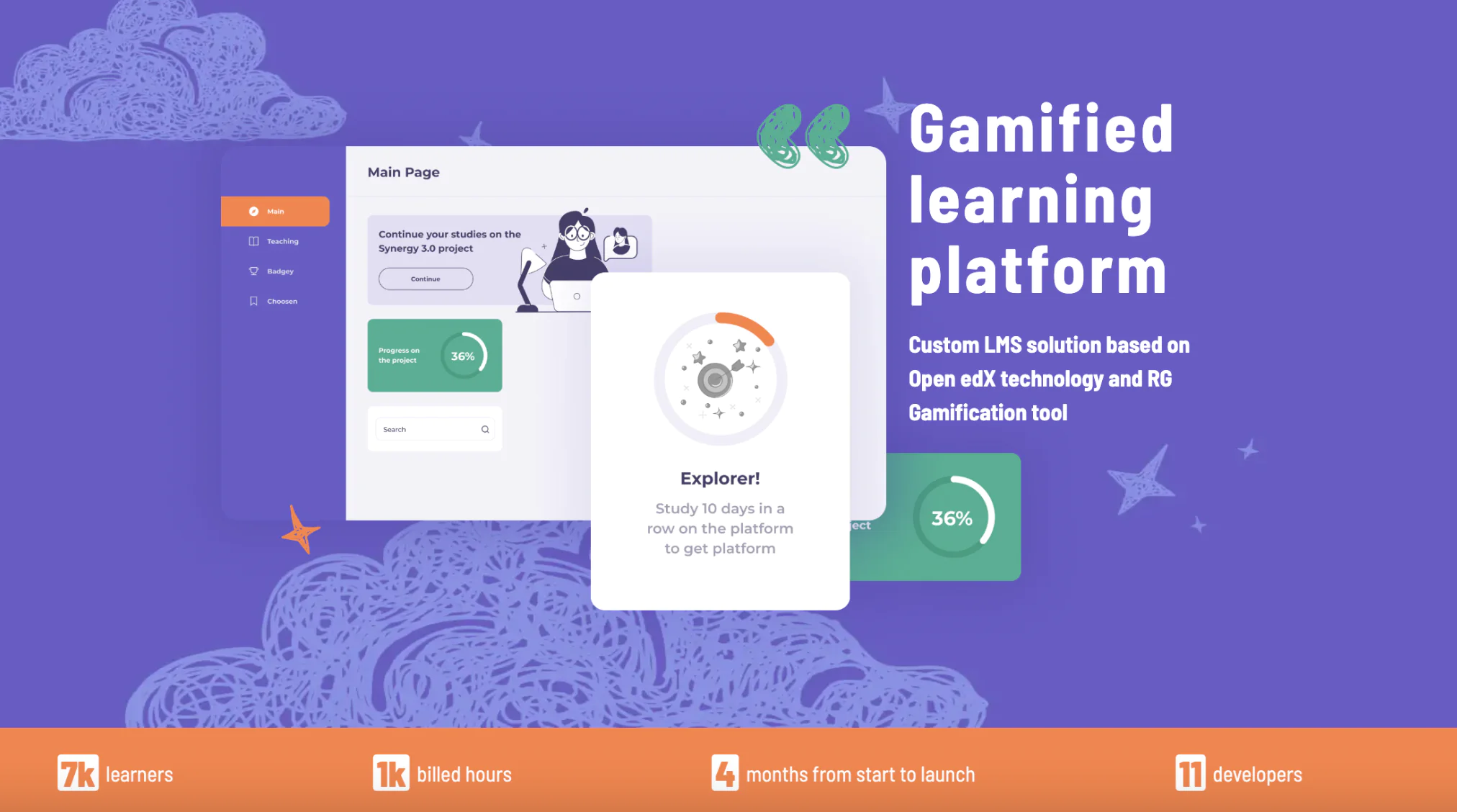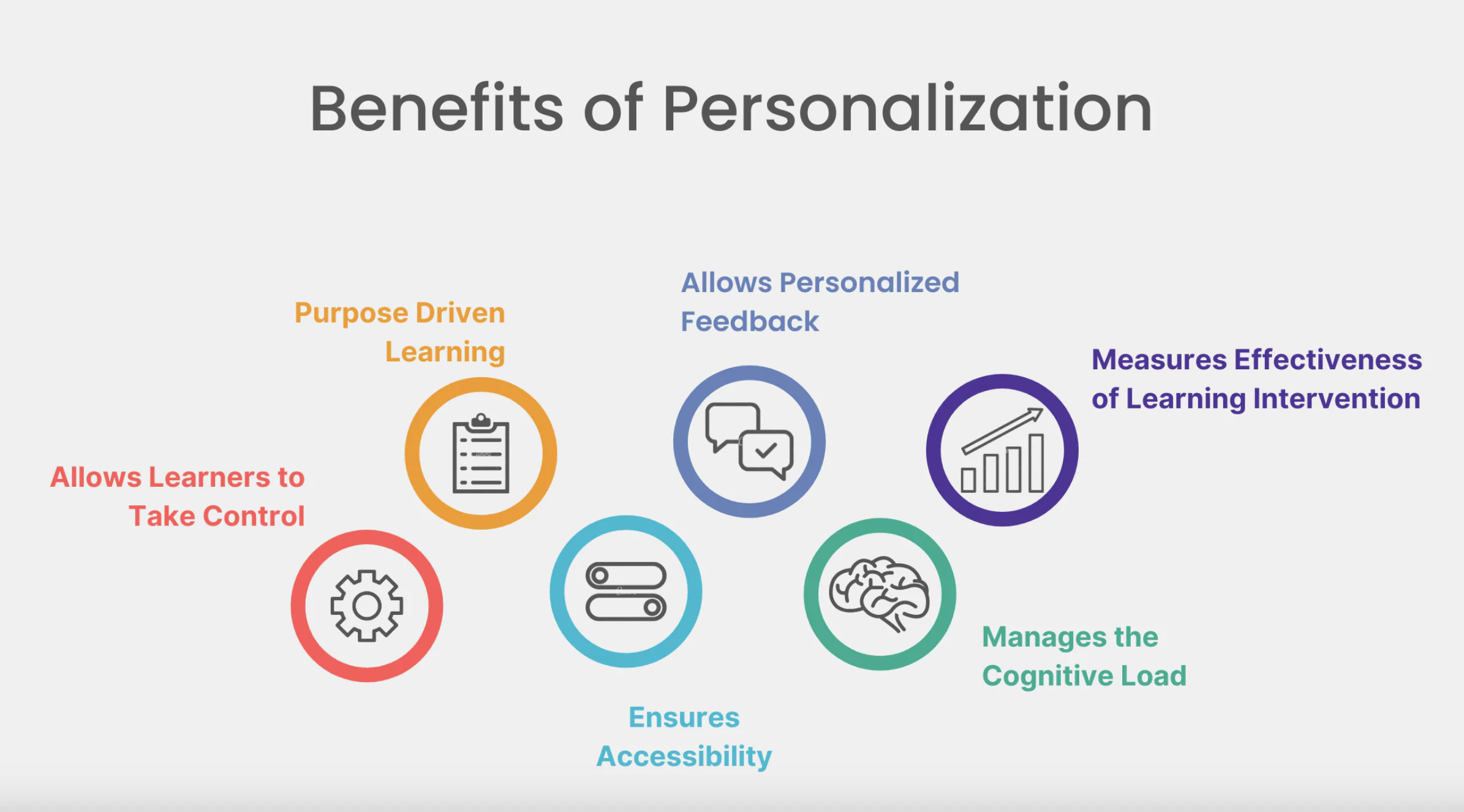Interactive videos, however, bridge this gap by allowing users to actively participate, choose their learning paths, and immerse themselves in the material. This leads to deeper engagement and a more effective learning experience. For instance, one of our clients who implemented an interactive gamified learning platform saw 80% of their users return with high levels of engagement.
Understanding the ROI of such investments is crucial. By incorporating interactive videos into your educational strategy, you’re not just meeting learner expectations—you’re investing in a tool that enhances engagement and learning outcomes, ultimately driving better business results.
This article clarifies the role of interactive video in education and provides practical advice on how to better use its potential in training programs. Without further ado, let’s dive in!
Key takeaways:
- Interactive videos can greatly improve learner engagement. Still, overcoming high production costs and technical barriers is crucial for successful implementation.
- Accessibility is vital for interactive content. Ensure that interactive videos work seamlessly across devices and internet conditions and provide equal access for all learners.
Educators should integrate interactive videos into a well-designed LMS to maximize their effectiveness and ensure smooth learning experiences. As stated in a recent study, over 70% of respondents agree that interactive videos increase the learning outcomes.
Top 5 Benefits of Interactive Video in Education
Interactive video is changing the landscape of education toward one that is engaging and personalized. Unlike traditional videos, interactive formats make learners active participants, encourage participation, and enhance the retention of knowledge. Below, learn more about the main advantages of interactive video in education and how it can enhance teaching and learning.
1. Improved Knowledge Retention
Using e-learning video benefits not only learners but educators as well, since visual information is always perceived better than any other type.
Interactive videos engage learners and help them apply knowledge through interactive elements, making it easier to remember. A study showed that interactive educational videos greatly improve knowledge retention.
According to our experience, participants who engaged with the interactive videos demonstrated up to 15-16% improvement in retention compared to those who watched traditional linear videos.
2. Personalized Learning Experiences
Personalization is now the key to delivering an exceptional user experience across all niches. Interactive training videos empower viewers with control, allowing them to tailor the content to their preferences and needs. Trainees can move at their own pace, focusing on areas that need improvement and closing knowledge gaps faster. The entire experience can be customized according to the unique set of decisions of individual users.
This flexibility enhances learning, enabling users to achieve more in less time. Students can also select content relevant to their roles, the one that will benefit them the most. Whether sticking to core topics or exploring additional material, interactive videos in e-learning offer a customized path to success.
3. Enhanced Student Engagement
While videos are an awesome medium for learning, watching without any other kind of engagement may lead to boredom and apathy. On the flip side, interactive videos can evoke much better engagement and participation from viewers as compared to passive videos.
You can boost engagement with a story-driven approach. Or, let viewers explore at their own pace by taking different paths. Hence, trainees can customize their learning experiences. Non-linear storyline flow has already revolutionized the gaming industry since this approach provides a tantalizing range of possibilities. Trainers can use a similar concept for their interactive videos to encourage learning.
The higher engagement factor can help learners retain more information and move faster. One relative advantage of interactive training videos over traditional methods is that you can include tests and quizzes at key points so that learners will remain vigilant of how well they understand the content that they have just covered. You may even set a certain minimum score that learners must attain to go forward.
Having plenty of quizzes and tests along the way can help learners consolidate their understanding of the subject matter and where they stand. Quite often, we end up thinking that we understood the content we just covered. But a few thought-provoking and conceptual questions from tests can help us uncover any deficiencies in understanding that may not be obvious at first. Thus, interactive training videos can help learners to excel and surpass expectations.
4. A Helping Tool for Microlearning
Microlearning is critical since it provides new nuggets of information in smaller, easily digestible sizes. This approach to learning will benefit a wide spectrum of users, especially in this era of shortened attention spans.
The interactive videos for learning and development play an important role in microlearning. They let authors control info flow and hold learners’ attention. These include real-time feedback, which turns learning into a more dynamic activity.
Basically, microlearning enables you to master the course in small increments, making learning easier and more relaxed. Content creators should take care not to exceed the attention span of learners, and interactive learning videos can help them to do just that by controlling the flow of information.
Flexibility within microlearning means that fast learners can easily process the content quicker at their own pace, still benefiting from such a focused approach.
5. Accessibility and Inclusivity
Interactive videos help test access and inclusivity in e-learning. They consider the diverse needs and preferences of learners. Most interactive videos allow for subtitles or transcripts, and adjustable speed. This lets learners with disabilities view the content on any device.
For example, learners who cannot hear or view clearly will be able to have easy browsing through such videos. Other interactive modules, like quizzes and clickable options, can help. They let learners set a good pace. So, the content can adapt to different learning styles.
This flexibility means the learning process is accessible to everybody, regardless of one’s ability or background. Interactivity in videos removes many barriers to access so that education becomes more inclusive and equable.
6. A Part of Gamification Success
Gamification reinforces learning through unified metrics for tracking improvement, hence making performance easy to manage and improve. For instance, think of adding a leaderboard that creates competition among trainees. Rewards and badges that are unlocked with each milestone completion motivate learners to achieve more.
Taking it to the next level, gamification allows interactive videos to present information in a very dynamic way to the students. They can apply decision-making and feedback in real-time. This makes lessons more fun and interactive than PowerPoint slides or PDFs. By turning it into a game, training ceases to be a chore but rather a rewarding challenge.
One key benefit of gamification is that it can help improve progress. Since it places different metrics at your disposal, managing your performance can become easier. The reason for this is that quantifying is necessary for anything that you wish to manage.
“When developing our RG Gamification Tool for LMS, we clearly understood its importance for platform managers and learners. And as practice shows, 95% of employees enjoy using gamified tools at work and learning.” — Raccoon Gang Development Team
Challenges and Best Practices of Implementing Interactive Videos in Education
Despite their many advantages, interactive training videos in education have challenges. We have identified common challenges in this section, along with best practices for the effective deployment of interactive video content in diverse learning environments.
Challenges
- High production costs and time investment
The key demands towards the integration of interactive video content into education are first of all high costs and intensive investment in time for producing quality materials. Generally, an interactive video requires more resources compared to traditional types. This normally includes preparation for branching pathways, designing interactive elements, creating multiple outcomes, and complex video editing software.
Also, creating interactive videos requires a mix of skills. These are instructional design, video production, and programming for the interactive elements.
- Technical barriers
Interactive video technology is greatly dependent upon digital infrastructure. This can be a challenge for institutions or learners who lack access to robust internet connections, adequate hardware, or modern browsers and devices.
Incompatibility with some Learning Management Systems (LMS) or mobile platforms can further complicate the deployment of interactive videos. That is why we at Raccoon Gang offer customized solutions for all our clients while developing LMS, so that our clients have high-end solutions for every unique case.
“As part of our cooperation with Axim, we proposed the discovery phase and technical design of a new video player for the Open edX platform. The updated video player removes the limitations of the previous version for all platform owners.” — Glib Glugovskiy, Dev Lead at Raccoon Gang
- Assessment and data collection issues
Interactive videos are often seen as a great way to embed formative assessments, such as quizzes or decision points, into the learning experience. Often it is cumbersome to integrate these assessments into existing grading systems or even to pull meaningful data for analysis by instructors.
Even though interactive videos might seem like a bit of a headache to work with, remember that benefits of video in e-learning justify the effort. Now, let’s talk about how to implement them into your learning curve the best way possible.
Best Practices
1. Start small, scale gradually
One of the best ways to overcome the cost and time issues is to start with small, simple interactive videos. Then, scale up as educators and institutions gain experience. Not every interactive video needs to be fully branched. Start with simpler interactions, like embedded quizzes or clickable info points.
How to do so:
- Modular approach: Short chunks of interactive videos, each focused on a single concept, are easier and faster to produce.
- Use existing platforms: Use easy, interactive video platforms like Edpuzzle, PlayPosit, or H5P. They have templates that speed up production.
- Iterative design: Start with pilot projects, gathering feedback from both educators and students to refine the approach before larger rollouts.
2. Focus on accessibility and compatibility
Ensure that interactive videos are accessible to all learners. Consider designing videos with low bandwidth options, mobile-friendly formats, and compatibility with multiple platforms. Universal design principles help maximize accessibility.
How to do so:
- Bandwidth-friendly design: Offer options for lower-resolution video streams and allow students to download content for offline use.
- Cross-platform testing: Test interactive videos on different devices (laptops, tablets, smartphones) and browsers to ensure consistent functionality.
- Accessibility features: Incorporate captions, transcripts, and alternative navigation paths for students with disabilities.
3. Use data for personalized learning
Educators should make full use of analytics tools within interactive video platforms to track student engagement, assess performance, and provide personalized feedback. Data can be used to identify learners who need extra attention.
How to do so:
- Automated assessment tools: Use interactive video platforms that offer automatic grading and analytics for quizzes and decision points. Platforms like Kaltura and Panopto integrate with LMS for seamless tracking.
- Personalized learning paths: Create videos that adjust based on student responses, offering differentiated content or additional help when needed.
Conclusion
Interactive videos in e-learning offer many benefits, which is why they are becoming common in corporate training. These videos help companies automate training, cut costs, and improve the learning experience. However, using them effectively comes with challenges like production costs, technical issues, and ensuring they fit with learning goals.
Whether you need to add interactive videos, manage assessments, or build a custom LMS, Raccoon Gang offers expert support at every step. We handle LMS creation, customization, and management to meet your specific learning needs, so you won’t need additional help.
Contact us today to discuss how we can help you create a platform that engages learners and ensures strong learning outcomes. Together, let’s shape the future of e-learning!











